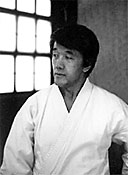vol 18, July 2001

Welcome to the June issue of Bu Jin's Online Newsletter

Sitting in a cool restaurant one Friday evening after class recently, replenishing liquids and having the de rigueur late dinner of martial arts practitioners, our conversation turned to summer travels and summer seminars. One student with ambitious travel plans asked how she could best take advantage of the upcoming seminars she expected to attend. Her aim was to make this an aikido summer, and she felt poised in her training to achieve some real growth.
I had to tell her that I thought her best bet at this time was to focus on the ukemi portion of training. As you know, ukemi is essentially "self-protection," (Uke= receive; mi= body) and there is much to be learned from the receiving side of training. Universal principles apply to all arts, and while my experience is in aikido, practitioners of other arts will understand the applications.
Reflections on ukemi
In the days when I was attending college, around the time I received my shodan in aikido, I really started to become interested in aikido and I went practically every day to Aikikai Hombu dojo to train.
Hombu dojo at that time had a truly incredible teaching staff, which would be unimaginable today, consisting of many of O-sensei's uchideshi (live-in students). I devoted quite a lot of time to training with these remarkable teachers, each of whom allowed me to feel their techniques, personality, and teaching styles -- which were derived through their own strengths and were therefore quite distinctive and unique.
And I remember the breaks in training, when we would all gather at a coffee shop to just talk about things. It was a very different dynamic than in the dojo. These "off-duty" occasions were opportunities for significant interactions with shihan on more personal levels than in the dojo.
Whether it was at the coffee shop or at the dojo, I remember asking the question, "How does one improve most quickly in aikido?" of shihan such as Yamaguchi sensei, Sasaki sensei, Saotome sensei and other advanced practitioners. Each of them, in their own way, said that in order to develop one's aikido, the best thing to do is to mimic one's teachers' techniques and movements, attend training continuously, and to learn how to manifest these movements through one's own body. The most effective way, they said, is to take ukemi from many teachers, in order to feel and learn the techniques and principles through the body.
I took this to heart and made an effort to take as much ukemi from as many teachers as possible. Of course, it took some effort even before I was able to be used as uke. First, I had to attend numerous classes with a particular teacher, so that he would begin to recognize me. Then, whenever he came around during training, I would turn to him and say, Onegai shimasu to be thrown by him. During these few precious moments as uke, I realized that it was very important that I have the sensitivity in my body to feel what he was doing. I knew I had to gain the ability to respond to any technique or throw that might occur.
One thing I noticed during training was that, in the interval between training in one technique and being shown the demonstration for the next technique, it was important to always watch the teacher's eyes. The shihan in Japan did not call out for the next uke by name but by a signal sent through their eyes. If we missed this signal, the teacher would very often quickly transfer his gaze upon another person. If this happened too much, the teacher might think that you had a deficiency in wanting to train, so you might be removed from the list of candidates available for receiving ukemi. One had to be constantly alert.
Keiko is not just the time spent in working with someone else; rather, keiko encompasses every moment between the beginning of training until the end. Working on techniques, watching the teacher's demonstrations, listening to his lectures and stories, and maintaining awareness of what is going on in the dojo -- all of these are part of keiko. One must become integrated into the training, even to the point of physical and spiritual exhaustion by the end of the session.
The more I paid attention to keiko and ukemi, the more I learned. I progressed beyond the stage of simply driving myself through ukemi to truly feeling the techniques of my teachers. It was then that I caught a deeper glimpse into the complexities and nuances of the art and was able to train with more clarity, even during the most vigorous training sessions.
Perhaps a focus on ukemi during summer seminar keiko will help us all become better practitioners of our chosen art.
*Translated by Jun Akiyama



